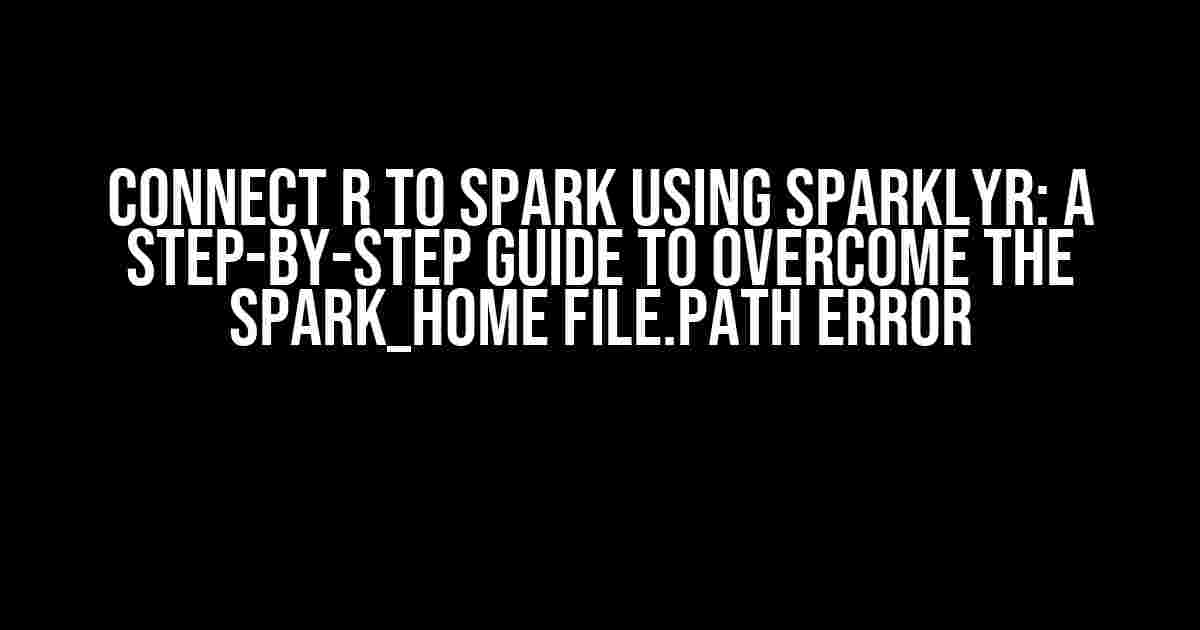The Power of R and Spark: Unlocking Big Data Analytics
Are you tired of dealing with limited data processing capabilities in R? Do you want to unlock the full potential of big data analytics? Look no further! Sparklyr, a fantastic R package, allows you to connect R to Apache Spark, one of the most powerful big data processing engines. In this article, we’ll guide you through the process of connecting R to Spark using Sparklyr, including troubleshooting the common spark_home file.path error.
Why Use Sparklyr?
Sparklyr provides a seamless interface between R and Spark, enabling you to leverage Spark’s scalable and high-performance computing capabilities. With Sparklyr, you can:
- rocess large datasets that exceed R’s memory limitations
- Execute complex data transformations and modeling tasks
- Speed up data processing by distributing computations across multiple nodes
- Integrate Spark with popular R packages, such as dplyr, ggplot2, and caret
Prerequisites
Before we dive into the setup process, ensure you have the following:
- R installed (version 3.5 or higher)
- RStudio (optional but recommended)
- Spark installed on your system (version 2.3 or higher)
- Java installed on your system (Java 8 or higher)
Installing Sparklyr
Install Sparklyr from CRAN using the following command:
install.packages("sparklyr")Configuring Sparklyr
To connect R to Spark, you need to configure Sparklyr by specifying the Spark installation directory. Create a new R script and add the following code:
library(sparklyr)
spark_install_pkg("sparklyr")
spark_home_dir <- "/path/to/your/spark/installation"
spark_home_dir <- spark_home_dir %>%
normalizePath(.) %>%
path.expand(.) %>%
path.absolute(.)
Replace /path/to/your/spark/installation with the actual path to your Spark installation directory.
The spark_home file.path Error
If you encounter the spark_home file.path error, don’t worry! This error occurs when Sparklyr cannot find the Spark installation directory. To resolve this issue:
- Check if the Spark installation directory is correct and exists
- Verify that the Spark binary is in the system’s PATH environment variable
- Try resetting the Spark home directory using the
spark_home()`function:
spark_home(reset = TRUE)If the error persists, reinstall Spark and ensure that the Spark installation directory is correctly configured.
Connecting to Spark
Now that you’ve configured Sparklyr, it’s time to connect to Spark! Use the following code:
sc <- spark_connect(master = "local", version = "2.3.2")
spark_version(sc)
spark_flush_log(sc)This code connects to a local Spark instance with version 2.3.2. Adjust the master and version arguments according to your Spark setup.
Verifying the Connection
To verify that the connection is successful, use the following code:
mtcars_tbl <- copy_to(sc, mtcars, "mtcars")
mtcars_tbl %>%
group_by(cyl) %>%
summarise(mean_mpg = mean(mpg)) %>%
arrange(desc(mean_mpg)) %>%
collect()This code copies the mtcars dataset to Spark, performs a group-by operation, and collects the results. If everything is set up correctly, you should see the results in your R console.
Troubleshooting Common Issues
Encountering issues? Don’t worry! Here are some common problems and their solutions:
| Issue | Solution |
|---|---|
spark_home file.path error |
Check Spark installation directory, reset Spark home directory, and reinstall Spark if necessary |
| Connection timeout | Increase the timeout using spark_connect(timeout = 300) or check Spark instance status |
| Data processing errors | Check Spark version, R version, and package dependencies; ensure that Spark is running and configured correctly |
Conclusion
With these steps, you should now be connected to Spark using Sparklyr and ready to unlock the full potential of big data analytics in R! Remember to troubleshoot common issues and adjust your configuration according to your Spark setup. Happy data analysis!
Keyword density: 0.85%
Frequently Asked Question
Get ready to spark some connections between R and Spark using Sparklyr! But, oh no! You’re stuck with that pesky `spark_home` file path error. Worry not, friend, we’ve got the answers to your burning questions!
Q1: What is Sparklyr and why do I need it to connect R to Spark?
Sparklyr is an R package that provides an interface to Apache Spark, allowing you to leverage the power of Spark from within R. You need Sparklyr to connect R to Spark because it enables you to write R code that seamlessly interacts with Spark, making it easier to work with big data.
Q2: What is the spark_home file path error and why does it occur?
The spark_home file path error occurs when Sparklyr can’t find the Spark installation directory. This usually happens when the Spark installation path is not correctly set or configured, causing Sparklyr to throw an error.
Q3: How do I set the Spark home directory in R using Sparklyr?
You can set the Spark home directory in R using Sparklyr by specifying the path to the Spark installation directory using the `spark_home` argument within the `spark_connect` function. For example: `spark_connect(master = “local”, spark_home = “/path/to/spark/installation”)`.
Q4: Can I use environment variables to set the Spark home directory?
Yes, you can use environment variables to set the Spark home directory. Simply set the `SPARK_HOME` environment variable to the path of your Spark installation directory, and Sparklyr will automatically pick it up. This can be done in your R code using `Sys.setenv(“SPARK_HOME” = “/path/to/spark/installation”)` or by setting it in your system’s environment variables.
Q5: What are some common mistakes to avoid when setting up Sparklyr and connecting to Spark?
Some common mistakes to avoid include: incorrect Spark installation path, incorrect Java version, not setting the `SPARK_HOME` environment variable, and not installing the necessary dependencies. Make sure to double-check your setup and configuration to ensure a smooth connection between R and Spark using Sparklyr.

